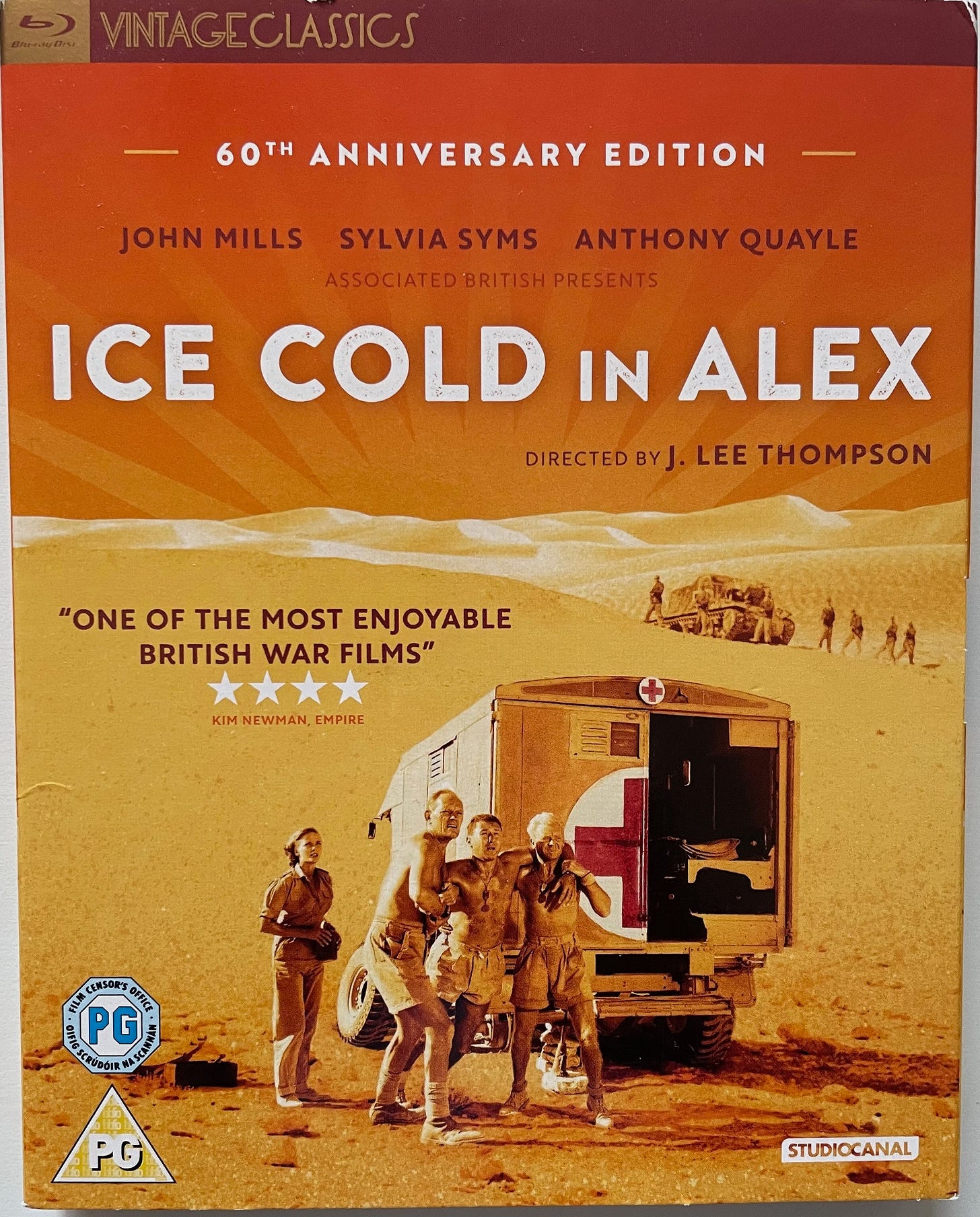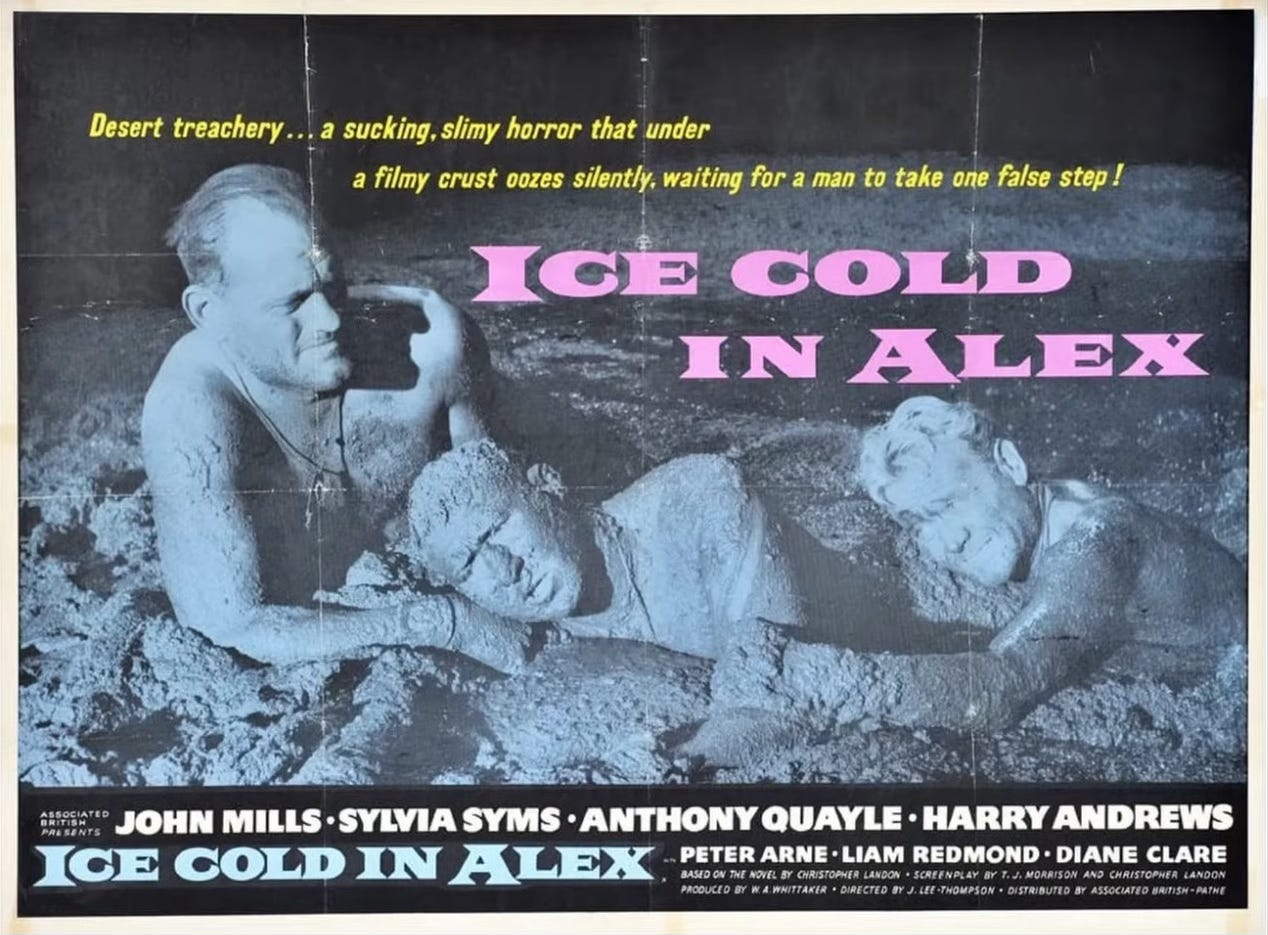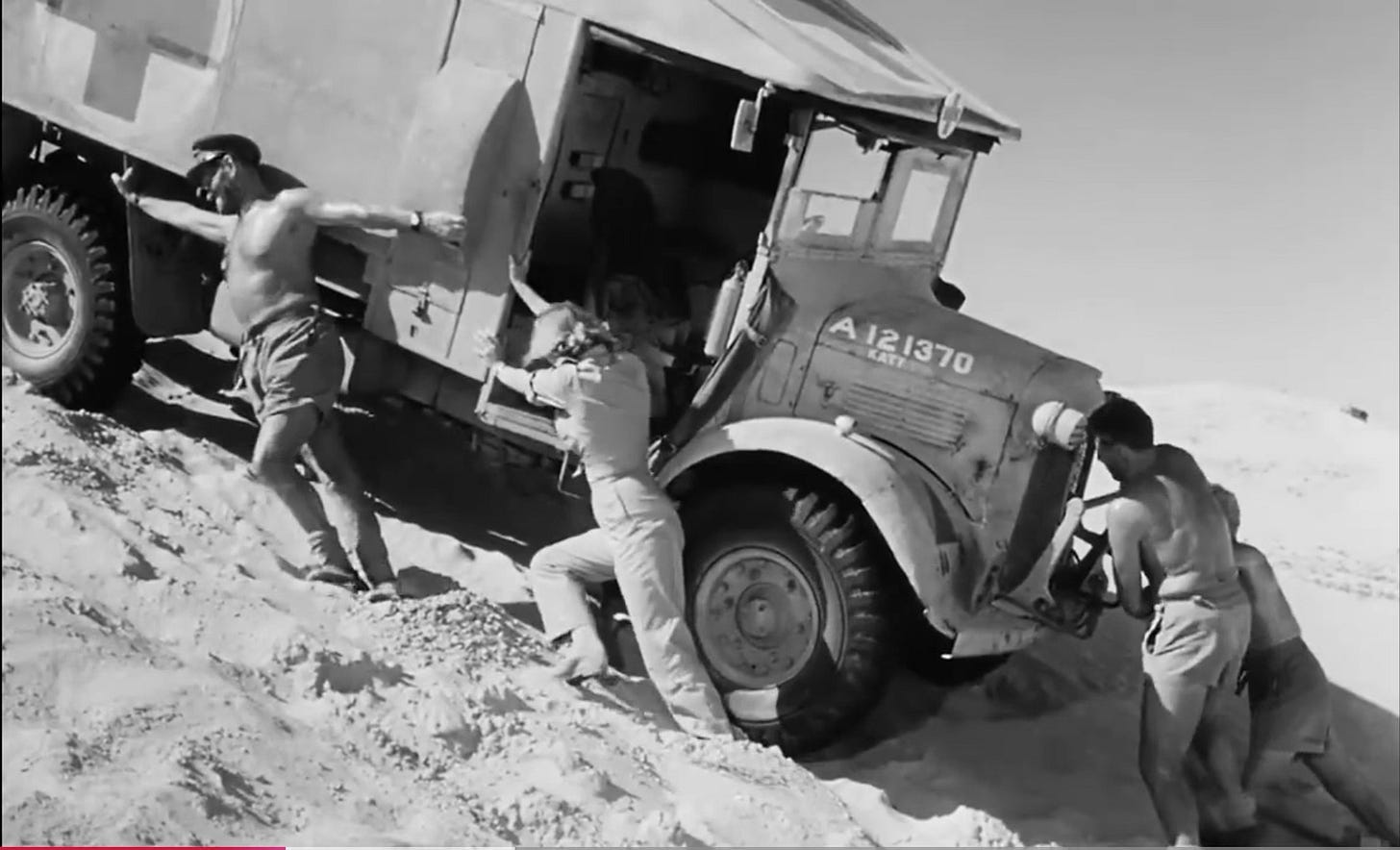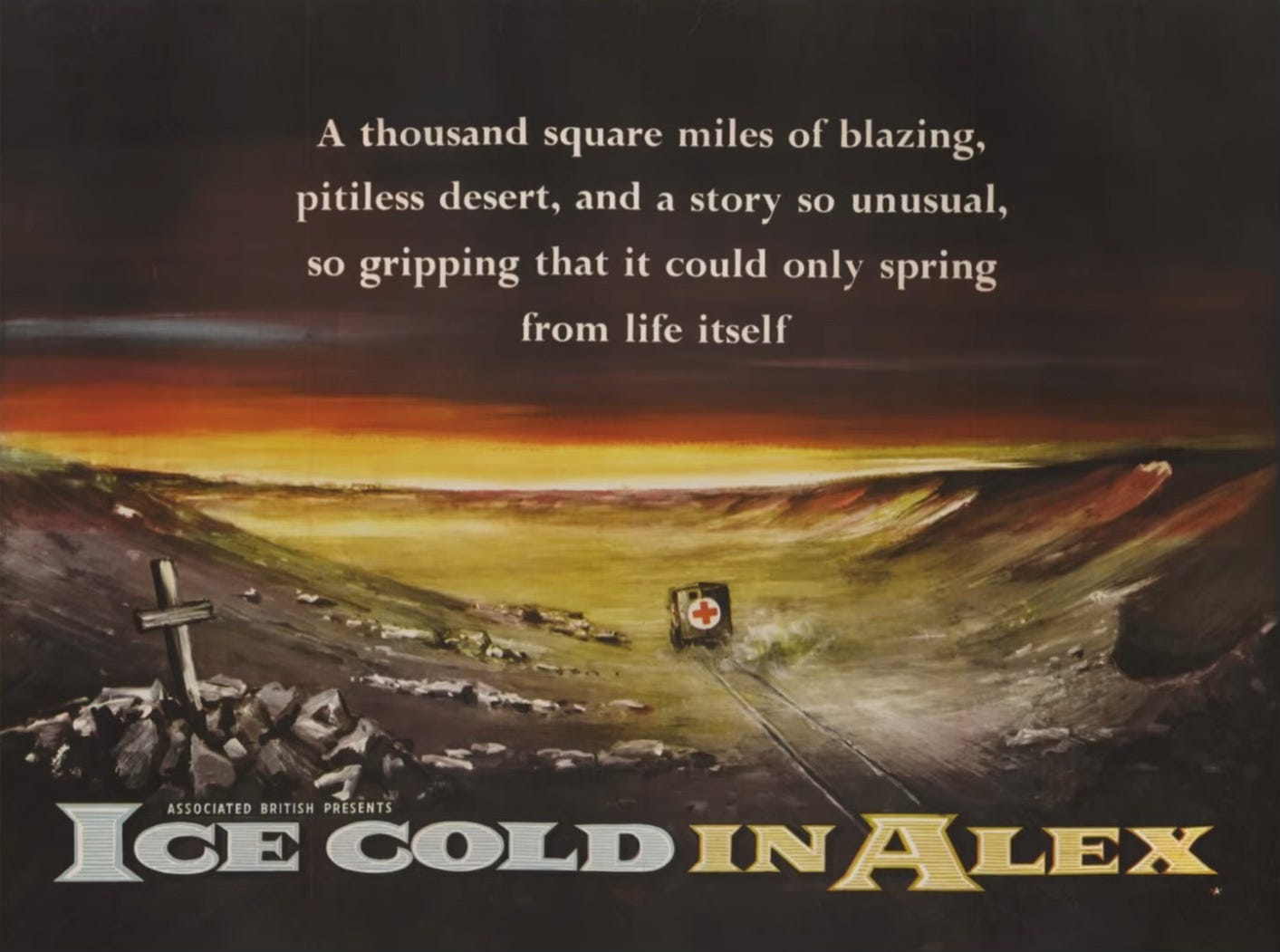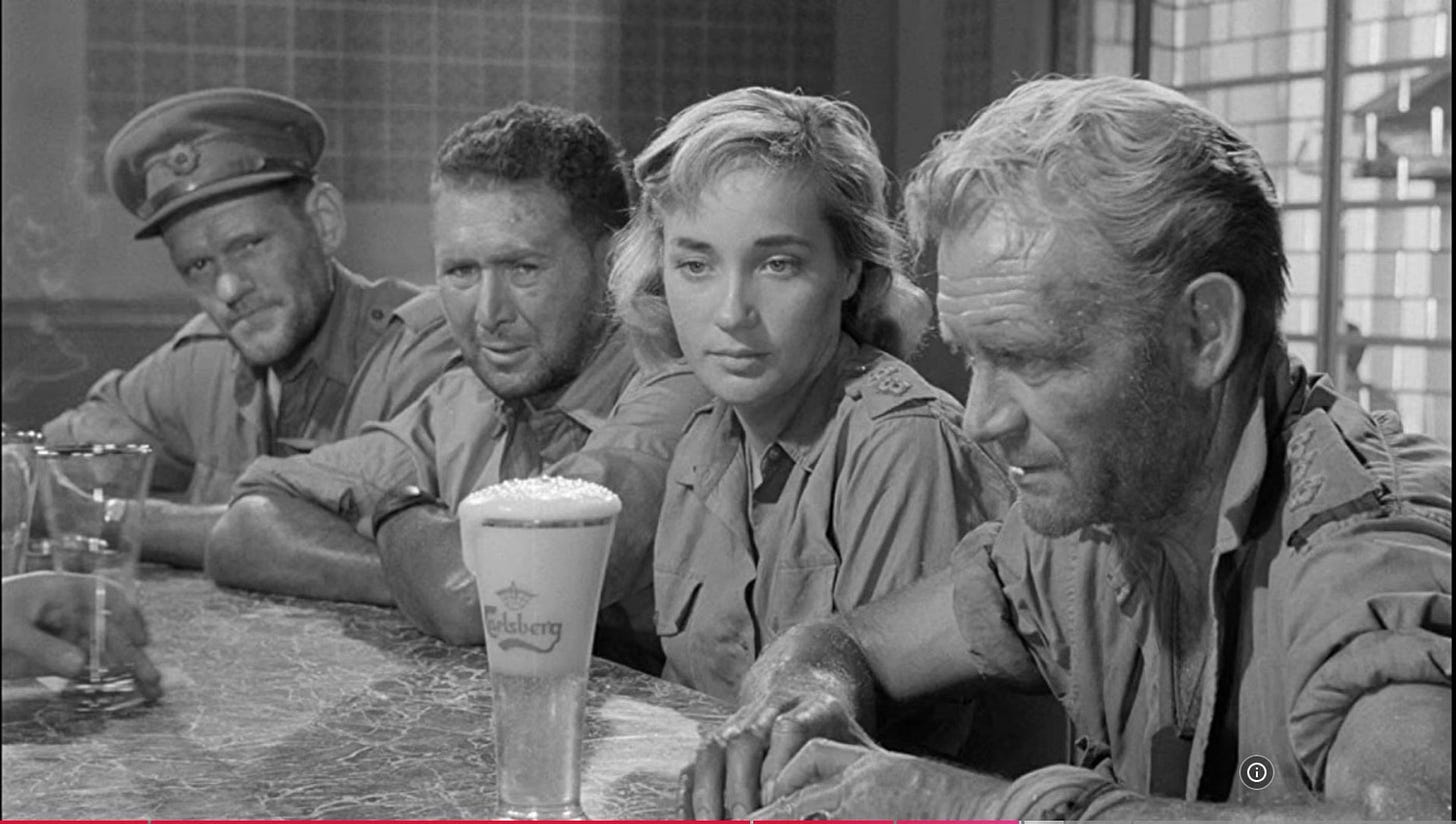Revisiting Rewatchables – A New Beginning, 14: “Ice Cold in Alex”
We leave Westerns behind us and return to war films. If you remember, war had already raised its ugly head in "E la nave va" and even more so in "Lifeboat".
The first time "Ice Cold in Alex" shows up in my little black book is 1974, but I am sure I had seen it before then. On TV, of course. I know I was deeply impressed and put the film on my "Best Films Ever" list.
I've mentioned this list before. Looking back, I realize that this list reflects not so much cinematic excellence as my young self which at that point spent a lot of time thinking about the horrors of WWII and pondering ethical questions. Maybe the most important question was (and still is): "How would I react if I were to find myself in this terrible situation? Would I be brave?" The characters in the films on my list showed me who I wanted to be in an emergency. They served as models, at least in theory. Frankly, I have no idea how I would act if put to the test. "Ice Cold in Alex" was for me one of those films that presented possible, harrowing scenarios and asked the question: "What would you have done?".
The film starts in June 1942 during the siege of Tobruk. The German and Italian forces are advancing, and the British are evacuating their people. Captain Anson (John Mills) is told to get 25 ambulances to Alexandria. However, he, his sergeant Pugh (Harry Andrews) and two nurses, sisters Diana Murdoch (Sylvia Syms) and Denise Norton (Diana Clare), are separated from the convoy and have to make their way to Alexandria on their own. At a depot they pick up a South African soldier, Captain van der Poel (Anthony Quayle). Anson is at first reluctant to add another passenger because they have limited resources, but van der Poel tells him that he carries several bottles of gin and is willing to share. That is when Anson agrees to add van der Poel to their group, because Anson is an alcoholic. He's been through a very bad time during the war and has started to drink, and he has lost his stash of whiskey.
So, the ambulance, called Katy, and the five travelers try to make their way to Alexandria. Through a scorching desert, where behind every dune might lurk German tanks. And indeed, they meet German troops, but thankfully van der Poel speaks German and can parlay with the German officers. Unfortunately, before the first of these encounters Anson panics and tries to evade the Germans, who then shoot at the ambulance. Sister Norton is badly injured. When they see her lying on the cot, the Germans allow the ambulance to move on. They even donate some bandages. At that point, sister Norton is already dead, but the British pretend she is only sleeping.
They drive on and find a place where they can bury sister Norton. This is when they have their next encounter with the Germans. Again, van der Poel talks to the commanding officer and the Germans allow them to drive on.
Pugh and sister Murdoch have become increasingly suspicious of van der Poel. Pugh is suspicious because van der Poel, who claims to be part of the South African army, doesn't know how to brew tea in the desert. Pugh says, that the South Africans brew their tea just like the British troops. Sister Murdoch is suspicious because van der Poel always takes his big and heavy backpack with him when he goes off into the desert to dig a latrine with a spade. The second time he talked to German officers he showed them something in his backpack. Pugh follows van der Poel one evening and sees him manipulating something that looks like an antenna. They tell Anson about their suspicions but Anson believes in van der Poel.
Katy and her crew reach a depot at an oasis and get more fuel and water. The British troops at the depot are busy putting sugar into the gasoline. That would be important information to convey to the Germans. That evening, as they are driving through dangerous terrain where there is quicksand, van der Poel walks off again with a spade and his backpack. But he has to stay near the track and the others manage to shine the headlights on him. He panics and tries to bury the backpack in the quicksand, but then he himself almost drowns in the sand, and the others manage to save him at the last minute.
Nothing is said about their suspicions and the backpack. They simply travel on, until they reach a final obstacle: a huge dune. The ambulance can't get over this dune. But then Pugh has an idea. The ambulance could be moved backwards over the dune by using the starter handle as a crank. Inch by inch the car crawls upward and they are almost on the top when through carelessness the ambulance rushes downward again. They have to start at the beginning, but thanks to van der Poel's strength and their combined effort they finally reach the top of the dune and have a glimpse of the sea.
They are near their final goal, Alexandria, or Alex, and the dream that had kept them going: an ice-cold lager at Anson's favorite bar. Hence the title of the film. But what to do with van der Poel? He was a spy for the Germans. There is no doubt about that. And as a spy he would be executed. But he had saved their lives several times during their journey. The three others don't want to see him dead. Anson tells the Military Police that they have a German soldier in their group who had surrendered to them and that they want to drink a beer together before he is being arrested. And that is what happens. They get their beer, and then van der Poel, or rather Otto Lutz as his real name is, is being escorted by the Military Police and driven off, while the other three look on. He had saved their lives and they have now saved his life.
One could summarize the story of this film as: "Lifeboat" in the desert, and you will find this description when you read about "Ice Cold in Alex". Indeed, there are quite a few similarities: a small group of people in an inadequate vehicle with limited resources, making their way through inhospitable and dangerous surroundings during wartime, unaware that one in the group conspires with the enemy. The big difference between "Lifeboat" and "Ice Cold in Alex" is the portrait of the enemy within the group and how he is dealt with, but then the war was long over when "Ice Cold in Alex" was filmed. It is easier to be sympathetic to the enemies once you have defeated them.
Another big difference between the two films is that "Lifeboat" was shot in a big tank, whereas "Ice Cold on Alex" was shot in the Libyan desert, with all the misery, but also the verisimilitude, that entailed. Sylvia Syms remembered the filming in an interview:
It might be difficult for people to believe this, but because of where we made it, there wasn't a lot of acting. We were those people. It was horrible. We were in Tripoli for a while when we took advantage of having a big American film unit near us, so we could go and catch ice cream and sit in air-conditioned caravans, and then the British Army, I think it was the Royal Corps of Signals, moved us up to the Gendarme's [?] plateau, which is not a sand desert, but a grit desert. So, when the wind blows, it was a called a Ghibli, it blows tiny little stones into your face, all the time. And the flies came from everywhere. I suppose it's called 'Method Acting'. We didn't call it that. We just called it, 'Getting on with it!' It was … it was horrible. Really horrible. But we were all very brave …
I went to see the film in Fulham at an ordinary cinema and I heard a woman say at the end of the film: ‘Isn't it marvelous what they can do in a studio nowadays?’ I reached for her throat to say, ‘No, we were there!’. But she obviously thought it was all faked.
It is many years since I've seen "Ice Cold in Alex" and rewatching it I'm no longer quite as impressed as I was the first time around. There are a few plot holes, for instance when nobody demands to see what's in the backpack that van der Poel carries around everywhere. And why is it only van der Poel who vanishes into the desert with a shovel? Don't the others have to go to the bathroom?
I find it also odd that they can drive criss-cross through the desert and Anson can put his finger on the map and say: "We are here," without so much as looking at the compass or taking any bearings. As to the climactic scene where Katy inches backwards up the dune, that is also unrealistic although very satisfying. According to a boffin (see link below) who has done the math, cranking the ambulance the way it is shown in the film would have taken days not hours, and there would have been an easier way to achieve the same goal. But it looks good on film, so I won't complain.
Ice Cold in Alex – was it real?
"Ice Cold in Alex" is both suspenseful and an ode to camaraderie, pluck, resilience and the can-do spirit the British were famous for. A small group of people fight the desert and survive against all odds. It makes me think of the famous speech from Henry V: "We few, we happy few, we band of brothers." Except here there is a sister too. And they all got to drink an ice-cold lager at the end. Cheers!


